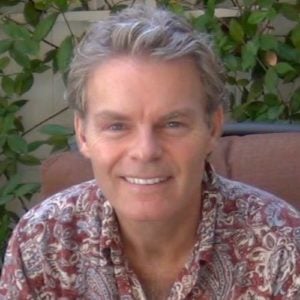I recently sat down with Sandra J. Shaw to ask her about her work, her views on art, and how she became a sculptor. Ms. Shaw’s sculptures are owned privately throughout the United States and Canada, as well as in England, Australia, Bermuda, Singapore. Her work can be viewed on her website, www.sandrashaw.com, or by appointment. The interview is accompanied by several images of the works discussed. —Craig Biddle
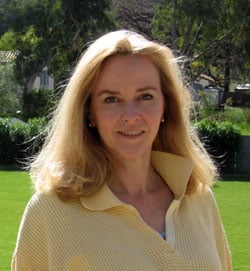
Craig Biddle: Thank you for joining me, Sandra. I know our readers will be delighted to hear from you and get a peek inside your fascinating world.
Sandra Shaw: My pleasure.
CB: Why did you choose a career in sculpture, how and when did it begin?
SS: I didn’t set out to become a sculptor; I had no interest in being an artist. I grew up in Canada, which did not have a thriving fine art culture that I was aware of, or a fine arts profession that was promising to me. The art schools where I grew up were preoccupied with anti-art. So I was not attracted to the art world or the lifestyle that I thought artists lived.
That being said, I ended up becoming an artist simply because I love making art. I just couldn’t get away from it. I tried. I did other things. For instance, I enjoyed writing and pursued a career in journalism for some time, which I thought would be an interesting living. But I never gave up my art.
I’ve always made art from as long ago as I can remember. I drew throughout my childhood—that was my passion—and I knew I was developing a facility for art. So I always knew that I would have art in my life.
While in high school I attended night classes at a couple of colleges to explore journalism and commercial art. I even made some headway in the commercial art business, making some album covers and posters for the music industry, of all things. But by the time I’d graduated high school, I knew I didn’t want a career in commercial art.
Sculpture came to the forefront when I was in my freshman year at university. I’d decided to pursue journalism and went to university so that I could become a knowledgeable writer. I didn’t want to have writing skills without knowing something about the world.
To pay tuition, I got a summer job working in the art department for the Royal Ontario Museum (ROM) in Toronto. At that time they were making a series of dioramas on the history of North American natives. A museum diorama is a three-dimensional scene that typically has figures and a painted or photographic backdrop. After a while it was apparent to me that the diorama project would be improved if they made better headway making the human figures.
I knew the scenarios they wanted for the dioramas, so I drew up designs of the figures and showed these to the head of the art department. That’s how I got the job of sculpting nine life-size human figures—my first job in sculpture, and three important years of studio experience in sculpture.
I picked the simplest, most fully draped figures to do first, and left the mostly nude figures for last. This way I could master the head and hands in the beginning, and after a couple of years was able to sculpt the full figure. That was great training. It was how I converted my brain from drawing to sculpting in three-dimensional form.
At the end of that project, I knew that I loved sculpture so much that it would be terrific if I could do this for a living. The idea of casting a figure into a permanent medium was thrilling to me, so I tried casting some small figures in bronze. And I eventually found that I could sell my bronzes.
I continued to study the figure in life drawing classes, and advanced my skills at the National Academy in New York.
CB: What have been the greatest influences on your work?
SS: The great art of the past and the human figure per se. I think the greatest inspiration and influence began with the drawings of Michelangelo and Leonardo da Vinci.
I don’t remember how I got my hands on them, but for some reason I had access to Renaissance drawings before I was ten. I suspect that they were featured in art books that my parents had. I remember being thrilled by the line work and the kinds of human beings that Michelangelo and Leonardo portrayed. Although I didn’t know it at the time, I was responding to the possibilities that those gorgeous, heroic figures suggested—they were god-like human beings with overarching gestures, physiques, demeanors. They captivated me. I examined and copied those master drawings. Later I had the opportunity to draw from Greco-Roman statuary in the ROM antiquities collection. That was long before I’d thought about sculpture, but I found classical form intriguing and pleasing. Those works showed a world of glorious men and women that stayed with me.
Anatomical drawings also had a big impact on me—both master drawings and drawings in anatomy books for artists. Around age twelve I started copying anatomical drawings. I also recall drawing a human skull at a natural history museum. The facts of anatomy were core to my understanding of what I was looking at in the Renaissance works, and the structures of the human body fascinated me.
Around the same time I became interested in the human face and in how a portrait can convey a kind of soul. I drew from photographs and from life—friends and classmates. The human figure and face have remained inspiring sources that translate for me a certain kind of life.
Another important influence on me was the discovery that there had been a professional world of fine art as recent as the early 20th century. Learning about the work and careers of artists in the 19th and early-20th centuries gave me a standard of professional excellence that I could strive for. (The lives and works of preindustrial artists did not offer me a relevant picture of an art career.) I learned about the academies and found out that there were excellent artworks in cities throughout Europe and the United States that had been made by talented, knowledgeable professionals. I traveled to see these works and read about that thriving, modern-age art world. This knowledge inspired me, and gave me an objective perspective on my own work.
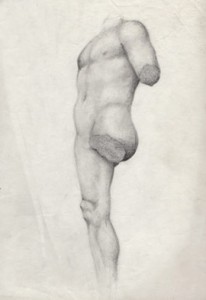
Study in graphite of an ancient marble fragment. Drawing by the Artist c. 16 years of age. Copyright © Sandra J. Shaw Studio 2011
In terms of artworks that have taught me something important, in historical chronology, I would say first is Thutmose’s portrait bust of Nefertiti from the Amarna period of ancient Egypt. It’s a timeless masterpiece—perhaps the first masterpiece in the history of art. The works of Phidias, master sculptor of the Parthenon. The fragments of his that most inspire me are his reclining “Ilissos” from the west pediment, his metope #27, and west frieze slab VIII. Jumping ahead to the Renaissance: Lorenzo Ghiberti’s relief panel called “Isaac” from his Gates of Paradise in Florence; Michelangelo’s David and his drawings for the Sistine Chapel ceiling; Leonardo da Vinci’s drawings of the human figure. Then jumping ahead to the 19th and early-20th centuries: Daniel Chester French’s seated Lincoln for the Lincoln Memorial; Malvina Hoffman’s allegorical figure for the Americas, in the Hall of Man, Chicago; the teaching models of Edouard Lanteri; the clay statuettes of Jules Dalou; and Frédéric Bartholdi’s magnum opus, the Statue of Liberty. There are more, but these are key works that taught me about sculpture.
I’ve been able to benefit from this artistic knowledge on an order of fulfillment that would not be possible without Objectivism as my guiding philosophy. By having a rational philosophy all aspects of my art are fully understandable to me, including my goals, my vision, my intellectual and technical methods. The Romantic Manifesto gave me enormous insight into the nature and significance of art. It enabled me to ground my love of the heroic in art in a fully rational philosophy. Objectivism protects and nurtures my propensity to learn and grow. My work will never become stale. I experience my abilities as ever growing. That will end someday, but only due to the infirmities of old age, not to infirmity of intellect or soul. I owe all that, and much more, to Objectivism.
Of particular value to me amongst Objectivist writings was the work titled “Metaphysics in Marble” by Mary Ann Sures [The Objectivist, February-March 1969]. That essay clarified for me the nature and potential of sculpture. It is one of the most important essays I studied that directed me on a course of learning what sculpture can be.
CB: What in your view does sculpture provide people, and how does it compare in this regard to other forms of art such as painting, music, and dance?
SS: I think sculpture more than any other art form dramatizes the realness of the subject matter—the fact that the subject being re-created and the idea that is being embodied are fully real. We may not consciously think of this when we view sculpture, but it is implied by the art form.
A sculpture embodies an idea in the form of a three-dimensional, physical object. That object is in our space that we live in. We can walk around it and touch it. What it embodies is being presented in a form that is as voluminous as the object it re-creates. And when it’s in a permanent medium, such as metal or stone, we can experience that object as a permanent presence in our living space.
Whereas painting—and I’m not denigrating painting at all, just making a distinction—a painting re-creates three-dimensional objects by portraying them on a two-dimensional surface, like a facsimile of that which exists. There are great advantages to this, since the painter can re-create many more types of things than can the sculptor, such as lakes, landscapes, clouds, the moon. But the viewer experiences the painted re-creation of objects as though he is looking through a window to another world; the vision is not experienced as being in the same world that the viewer lives in.
With performing arts like dance or the theater, you go to a place, you see the performance, and then you come home. In a sense, you’ve visited a certain kind of world. That experience, or vision, can be about something fully real, but the vision is not embodied in an abiding, physical entity. Once you’ve left the theater, the experience is held as a memory. You can’t come home to it, so to speak.
There is no physicality to music. You can conjure a world in your mind as you listen to it—and in that way you can give it a kind of visual reality—but there is nothing physically real being experienced. Of course, there are real musicians, but that’s not the music. There’s the sound of the music, but once the sound ends, it’s gone. You have to replay it to continue to have that experience. Again, this is not a criticism of music, just a distinction. Each art form has its distinguishing characteristics that serve our different faculties.
A sculpture embodies an idea in the form of an object shaped in a certain way, and in this sense it’s more closely aligned with architecture. It presents a conceptual vision in a form that you cannot pass by on the wall—to avoid it you must step around it, or not go into the place it occupies. I love how a sculpture owns the place it occupies.
CB: Let’s turn to some of your sculptures. I’m particularly interested in your busts of Ayn Rand and Michelangelo. Why did you choose Rand as a subject?
SS: Well, I love her. I make artworks of things I love. When you’re putting that kind of effort into something, you have to love it to do it!
I thought of doing a portrait of Ayn Rand years ago, but if I was going to make one for public display I preferred it be in the context of someone else clearly valuing it. So when Mary Ann Sures and John Ridpath [retired professor of economics and intellectual history] came up with the idea that I do her portrait, I jumped on it.
Dr. Ridpath had sent Mrs. Sures photos of my portrait bust called Arrival. She was impressed by the work and said to him that I could do a portrait of Ayn Rand—a thought that had already crossed his mind. Dr. Ridpath let me know of their conversation and suggested I contact Mrs. Sures. I knew that she was an art historian who had been in a close relationship with Ayn Rand. That meant to me that if I could consult with her, I would have a unique context in which to work.
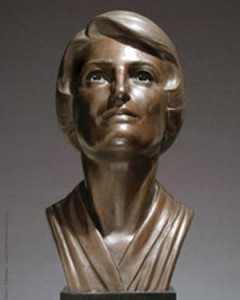
Front view of The Ayn Rand Portrait Bust in bronze. Copyright © Sandra J. Shaw Studio 2011.
CB: What kind of research and planning did you do in preparation for this piece?
SS: This work demanded a lot of preparation. I knew I’d be handicapped by the fact that Ayn Rand was no longer alive and I could not sit down with her, which would have made it much easier. I had never met her. I had seen her speak at her last talk in Boston at the Ford Hall Forum, but I was at least ten rows back, and she was elderly by then. Photography is limited in providing the type of information that a sculptor needs. But I knew that there were a lot of photos and videos of her. So that’s what I started with.
I collected photos and videotapes of her. Unfortunately, I found that the many photos were not good sources because most depicted her smiling, and none were a true profile. That makes it very difficult for a sculptor because you really need the profile. You need the straight on, the profile, and you need a three-quarter view.
After some weeks I found one small profile of her taken in her twenties, but it was the size of a postage stamp. Even then, the face changes as it ages, and I did not want to portray her that young. I wanted her in her thirties or forties, as a fully formed adult. After some months I did finally find a near-to-true profile of her as an adult, and with an at-rest expression.
Once I had enough information, I examined and drew from these materials. I call this my indoctrination phase in which I impressed my subconscious to the point where I had formed a pseudo-memory of her—as though I had known her. I could easily see her in my mind’s eye animated with life, at rest, or talking. I could conjure her face, from any angle, and see the shimmer of her expressions. That process took about two months.
The next step was to model a small, clay maquette, which I then showed to Mrs. Sures—first in photos, and then in the round. (I modeled it to be small enough to take on board an aircraft.) There was a period in which I made modifications to the maquette based on Mrs. Sures’ recollections and suggestions. For instance, she spoke about Ayn Rand’s mannerisms. This was very important information that helped me to better visualize her and adjust the maquette accordingly.
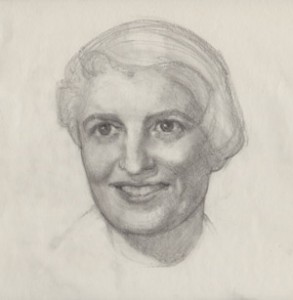
Study by the Artist in graphite from a photograph of Ayn Rand. Preparatory sketch for the portrait sculpture. Copyright © Sandra J. Shaw Studio 2011.
One memory in particular that Mrs. Sures had that turned out to be important to the work was that of Ayn Rand preparing to go out. She would naturally check herself in the mirror to see that everything was in place, and when she did this, she would lift her head a little and put her lips together for a moment. Then out the door she’d go.
This came up because in an earlier version of the maquette, I’d had her lips slightly parted. Many of the at-rest photos showed her with parted lips, and she had a slight overbite, which made her front teeth catch her lower lip. I’d become endeared to that because it was her, and that’s how I saw her in my pseudo-memory. Also, in terms of the moment that I was dramatizing—in which she sees John Galt—I thought that her lips would part slightly.
But when I showed photos of the maquette to Mrs. Sures, she said that that was just not how she remembered her. Then she told me of her recollection, of Ayn Rand getting ready to go out. And that made me think, “I don’t want to portray Ayn Rand as if she’s been caught off guard and she’s just stumbled upon John Galt. I want to give her a chance to prepare for this important encounter.” If she were meeting John Galt, she’d prepare herself first. So I remodeled her lips together.
CB: For her to look at John Galt would be a bit like looking in the mirror anyway.
SS: Yes. That’s a lovely way of thinking about this.
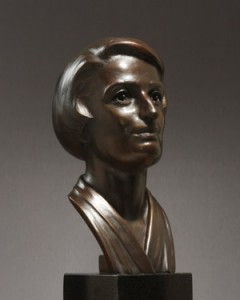
The Ayn Rand Portrait Maquette in bronze. Copyright © Sandra J. Shaw Studio 2011.
CB: That’s a wonderful story. It makes that feature of the portrait even more powerful to me now.
SS: After I settled the major issues of the maquette, I went into the 22-inch-high clay. Before I finished the large clay, I showed it to Dr. Ridpath, who had also spent some time with Ayn Rand. That was also a terrific experience; his response was very powerful, and this told me that the work was conveying what I wanted.
An unexpected puzzle that came up was deciding the drapery: what to have her wear. I didn’t want to suggest the nude, as the work could end up on public display—perhaps the lobby of a university campus building—and I didn’t want to portray Ayn Rand exposed like that as a woman. So I decided she had to have a garment.
Ayn Rand liked to wear camp shirts, or blouses that fitted close around the neck. But these didn’t work in sculpture. I tried the high-collared blouse, but it produced an ecclesiastical look, so that was out.
I knew that I wanted an openness to the neckline because Ayn Rand is open to the world. And I wanted something simple. The drapery I settled on is based on a blouse I have that worked perfectly. It has a small gathering of folds along the top of the shoulders, which send vertical folds down on either side of the lapel that give the garment a classical quality.
I had planned at one point to have the bust come down to the diaphragm (mid-waist). I’d visualized this design with simple drapery creating a tall vertical up to her face, suggesting a cape—which she loved to wear—and in my mind’s eye it was beautiful. But when I made the prototype in clay, the tall proportions just didn’t work. It detracted from the face. Mrs. Sures was very helpful with this issue as well. We discussed the classical portrait busts she was familiar with, and that work so well visually. That conversation settled the proportions that I ended up using.
In terms of Dr. Ridpath’s input, his response to the work told me about how successfully the bust captures a certain aspect of Ayn Rand’s soul. His and Mrs. Sures’ response to the work in this regard were crucial. Only those who knew her could confirm that I was on the right track with it.
CB: What’s the theme of this sculpture—I’m assuming you worked from a theme—and which features do you regard as most important in expressing it?
SS: Actually, I don’t work from themes. I don’t start with a theme, but rather with the subject. A theme emerges once I’ve explored the subject. The theme at times does not become clear to me until I’m fairly advanced in the research. Once I’ve realized a theme, I work consciously to dramatize it.
That said, the theme of this work is Ayn Rand’s capacity for man-worship, which was a unique characteristic of hers. I don’t know any other thinker who was a man-worshipper on the order that she was. Her capacity for responding to the best in man with reverence is one of the things that has kept me enamored with Ayn Rand as a soul. Recalling that capacity of hers was a big motivator and guide while I worked.
The purpose of this portrait was not to depict her exact likeness. To create a literal physical likeness of her without alterations to her features would be an interesting project. But with this work I wanted to dramatize her soul, and that required some changes to her features. This came fairly naturally while I worked.
CB: So given the theme—Rand’s capacity for man-worship—what features of the bust are most important in conveying it?
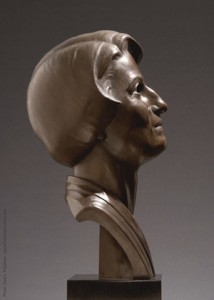
Profile view of The Ayn Rand Portrait Bust in bronze. Copyright © Sandra J. Shaw Studio 2011
SS: Her eyes and the direct set of her face. Her head is not turned to the side but faces directly ahead, slightly raised—a position that dramatizes her in a moment of seeing her ideal man. That pose is uplifted, direct, open, simple.
CB: It shows undivided attention.
SS: Absolutely. And her eyes were such a dramatic feature of her face. People who met her would remark that her eyes were large, dark, and riveting. I didn’t set out to make her with big eyes, but as I became absorbed with what she looked like, and what my pseudo-memory of her became, I began to dramatize her eyes as large and dark with reflecting glints. Mrs. Sures recalled that her eyes were very dark brown and shining—as if Ayn Rand were looking into a blue flame. This remark made the darkness of her eyes more real for me. It also added significance to my describing the highlights of her eyes in the form.
To render the eyes, I chose the concavity as opposed to the convexity. With her face uplifted, convex corneas would reflect a lot of light creating walleyed, blind-looking orbs. It wouldn’t have looked like her. But with the concavity, the irises fill with shadow cast by the “eave” of eyelashes above. The glints of her eyes are achieved with a protruding “peg” that emerges from the iris and catches the light.
CB: That’s fascinating. I didn’t know about that technique.
SS: Yes, and it helped me get those deep, dark, penetrating eyes—which was true of her and dramatized the theme. Her gaze is open without being dazzled, or “visionary.” She is engaged without being in awe. I aimed to depict a look of earthly reverence.
CB: You succeeded!
Turning to Michelangelo, I essentially have the same questions here. Why did you choose him? What research was involved? What is the theme, and what features are most essential in conveying it?
SS: The core reason is the same. I love him. I love his work—the way that he portrays man. So he was an easy subject for me to dramatize.
It was, however, difficult to find sources for his likeness that I wanted to work from. There are a number of portraits of him, but they are not from live sittings. The most widely reproduced portrait bust of Michelangelo is by Daniele da Volterra, a young contemporary who knew him, and so Volterra would be a reliable source for Michelangelo’s likeness. However, Volterra portrays him flat-faced with a broken nose.
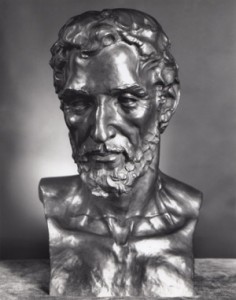
The Artist's portrait bust of Michelangelo in bronze. Copyright © Sandra J. Shaw Studio 2011.
I do not like Volterra’s manner of portraying him, so I kept looking and happily found a portrait that was from firsthand observation of Michelangelo and that did not portray him so flat-faced. It’s a handsome profile of Michelangelo in relief by a colleague of his, the medalist Leone Leoni. I came across this medal at the Bargello in Florence. The second source, which is less reliable than the Leoni profile, is a painting by Jacopino del Conte, another younger contemporary of Michelangelo’s. I came across a copy of Conte’s portrait in Rome. The Leoni profile and the Conte painting were the two main sources for my work.
As with the Ayn Rand bust, I wanted to glorify him. I was not after a literal likeness. I took his basic physiognomy and created the best, most exciting, most compelling face out of that.
CB: What theme emerged here?
SS: Michelangelo’s pride—his love of his own work. I thought of him looking at his work—specifically at his David. I thought of him being aware of his own mastery and of his satisfaction at what he’d achieved. So, in a sense, the theme would be his love of his own ability.
CB: What characteristics are most crucial to convey this?
SS: That subtle expression of pleasure, which is set by the mouth and associated cheek muscles. The wrinkles at the corners of the eyes suggest a smile as well. His vital physique implies that his work has not depleted him. The healthy full waves of hair also suggest vitality. His brow is serious but not pained. There is no suffering in my portrait of him, only triumph.
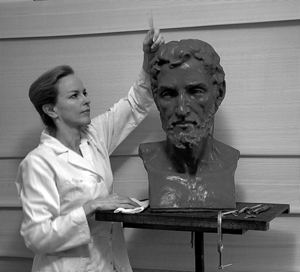
Sandra Shaw refinishing a wax pour of her Michelangelo portrait. Copyright © Sandra J. Shaw Studio 2011.
CB: Of all your sculptures to date, which is your favorite and why?
SS: Oh, I don’t have a favorite. That’s like asking a parent which of their children do they love the most. I love different works for different reasons. I could say that I’m most attached to the work that I’ve made most recently.
CB: What do you find most rewarding in the creative process, and what do you find most challenging?
SS: The best part of the creative process, for me, and what feels the easiest, is the actual making of the artwork—particularly when I’m in the zone, in tune with my subconscious, and I have no sense of time. That’s the easiest for me, whether drawing or sculpting. It feels like it doesn’t take anything; it’s just there.
Everything else is very difficult, and I couldn’t pick one thing that I experience as the most difficult. All other aspects of the work, refinishing the wax and the bronze casting, handling the foundry end of it, getting the piece photographed properly, displaying it, all these sorts of things are hard work. But the actual making of the work of art for me is a breeze by comparison.
CB: What’s involved in the physical process of producing a sculpture after you’ve made the prototype?
SS: Well, if my original sculpture is in clay, we first make a mold of it. I don’t make the mold myself; that’s a skill for a professional mold-maker. For a simple portrait bust, they make a two-part rubber mold with a detachable plaster casing, or “mother mold.”
Once the mold is made, they remove it from my clay prototype, then reassemble it as a hollow mold. The foundrymen then pour wax into it to coat the rubber interior. Once this wax solidifies, they pull apart the mold and release the wax form, which is now a hollow replica of the clay original.
The rest of the foundry process, through to the patinated bronze, is fascinating, and I have videos of the casting of the Ayn Rand portrait on my website [www.sandrashaw.com/ar.htm]. The videos are much easier to follow than any explanation I could offer here.
CB: Have you worked with stone or materials other than bronze—and if so, what, and if not, why not?
SS: I’ve sculpted in wax, in oil-based and water-based clays. I’ve had my works cold-cast as well as hot-cast. Cold-cast is with either bronze powder or marble powder suspended in fiberglass resin. A cold-casting is very lightweight, and looks the same as marble or bronze.
I’ve had, oddly enough, vivid dreams of carving into marble, and I do own a block of gorgeous white, Carrara marble from Italy. Perhaps someday I’ll go into it. Just out of curiosity I took a chisel to it, to see how it felt. I placed the chisel on the marble and gave it a tap with a mallet, and there was absolutely no effect on the surface whatsoever. So I then gave it a firmer hit, and again there was not a mark on it. I then clobbered it as hard as I could, and I looked and there was this tiny, tiny mark. And then I realized what I was dealing with. This, for me, would definitely require hydraulic tools, in a space where I could make a lot of noise and a big mess. Someday I may do that.
I’m also aware that the skill of going into stone and finding the form is different from the skill of modeling—of building up. I think it takes more knowledge and skill to go into stone and find the form than it does to model a soft medium. I liken it to oil painting versus watercolor. With oil painting you can make mistakes and alter things as you go, but if you’re doing watercolor and you touch the paper with the color, that’s it; you’re committed. You have to know a great deal way ahead of time with watercolor, and the same is true for going into stone—you have to know when to stop, and you have to know where the form is inside the block. You can’t wrestle with it.
Needless to say, I’m in awe of the great carvers who didn’t have power tools. Michelangelo went into the stone with the power of his biceps and made his David in two to three years–and while he was doing other works (his Tondos). And he carved until he was nearly ninety!
CB: What advice would you offer to someone interested in becoming an artist?
SS: That depends on who’s asking. If they’re a young person, or their parent, I would have a very different answer than for an adult. For a young person who’s interested in art, I’d be very encouraging.
The first thing I’d recommend is that they draw—trace, copy, and work freehand from direct observation—whatever they can master at first. They should have lots of sketchbooks and pencils, erasers and markers, whatever it is they want to use in the beginning—I recommend pencils.
If they love cartooning, they should not be discouraged. I did this a lot as a kid. Cartooning trains the mind to essentialize because it’s all about dramatizing a subject in terms of its essentials. So it’s not trivial.
A child interested in art needs the opportunity to draw real things from direct observation—people, plants, animals, houses, cars, whatever they want. I’d also provide them with books of master drawings from the Renaissance, pictures of artworks from ancient Greece, the Renaissance, and the 19th century, just to expose them to art. Certainly I would not expose them to anti-art, or let them run loose in a modern art museum. I’d be highly selective in what art I exposed any child to. Of course, when they’re older they can decide for themselves—and I think most kids, if they’re brought up rationally, can decide on their own that anti-art is not important. It’s good to make fun of anti-art freely in front of them, and show them that you think it’s too silly to be taken seriously.
For the older child or youth, there are art classes, or they can use how-to-draw books at home. They need to have a scientific base for what they’re doing, and they need to have a rational method for learning, so they’ll need anatomy books, natural history material—books on the nature of their subjects, from clouds to tree roots. For the budding sculptor, they’ll need clay, and eventually instruction on how to build an armature. A fun way to start in clay is for them to make elementary shapes of the egg, the sphere, the cube, the cone, and so forth. Simple, organic objects from observation, too: the apple, for instance. When they get older, they can progress to drawing plaster casts and life drawing. You can ease them into that by having them draw the draped figure, if you can find a drawing class where they have models wearing costume. And then eventually they’ll need to draw the nude. This last is crucial if they’re interested in sculpture. If their direction is to painting, they should eventually sketch out of doors. There are outdoor paint classes.
Eventually they should enroll in an art academy or private atelier. New York has some good training: the Art Student’s League, the National Academy, and the Grand Central Academy are good. There’s a solid list of ateliers at the Art Renewal Center.
So there are ways for a young person to seriously begin the journey to become a professional-grade artist or to create fine art for themselves. It also gives them a skill set for other activities, such as draftsmanship for architectural rendering, animation for the film industry, and, of course, the whole realm of graphic digital arts. Interestingly, some of the best talent today is in the animation studios.
If an adult who has not practiced art before were to ask my advice about how to become a professional-grade fine artist, I would encourage them to pursue art instruction for their personal fulfillment. I would not discourage the exceptional—there are always exceptions—but in most cases I could not otherwise advise them.
I’ll add that the ability to create art is acquired; it’s not inborn. We’re born with certain faculties, but what we make of them is up to us. It does not follow, however, that anyone can become a professional-grade artist at any time in life. Like violin playing, it requires many years of programming neural pathways, training certain muscles—what’s called “muscle memory”—automatized hand-eye coordination, and more deeply, the automatized ability to discern certain relationships, among other things, which is all best when “hardwired” in childhood, or no later than youth.
CB: What are you working on presently, and what are your plans for the future?
SS: I’m presently working on a textbook on art history, and filling orders for the Ayn Rand portrait. Those are my two main projects. When I get writer’s block, I work on my orders; when my hands tire from refinishing, I write. Between the two, I think I’ll keep my brain and my hands healthy. I’m very busy.
CB: What can you tell me about the book?
SS: It’s an art history text for senior high school-early college level. I hyphenate that because the general reading level of textbooks for senior high school in the early 20th century was about at today’s early college level. So it is optimistically for tomorrow’s high school student, and hopefully even some senior elementary school readers. It’s on the history of art from prehistory through to modern times—covering painting, sculpture, and architecture.
CB: Do you have an ETA on that?
SS: I originally gave myself three years. I think it’s going to take a little longer, but I’m basically on track. I’m completing the first draft.
CB: That’s exciting—I look forward to reading it. Finally, where can people see your work or read more about it?
SS: At my website: www.sandrashaw.com. I sell my works exclusively through my studio or from my website. I’m not currently exhibiting—I simply don’t have time. I will at some point, but not for now. Those interested in acquiring the Ayn Rand portrait bust can view her at www.sandrashaw.com/ar.htm. As well, those with a smaller budget may be interested to know that they can purchase the maquette in bronze.
CB: So if someone were interested in a sculpture he saw on your site and wanted to see it in person, how would he go about doing that?
SS: After October 14, the large portrait of Ayn Rand will be on permanent display at the Ayn Rand Institute in Irvine. My other works can be viewed by appointment.
A future project I’ve been thinking of for the large portrait of Ayn Rand is to get her onto college or university campuses—in the United States and eventually around the world. I think there’s potential there if I could work with those who want Ayn Rand’s portrait installed on campuses—people at those schools, or who know someone on those campuses—to get Ayn Rand into the universities.
That would be the project from heaven—to get Ayn Rand’s portrait onto university campuses.
CB: Indeed it would—best success with that!
Thank you very much for your time, Sandra. It’s been a pleasure.
SS: Thank you. I enjoyed it.


![[TEST] The Objective Standard](https://test.theobjectivestandard.com/wp-content/uploads/2017/10/logo.png)







